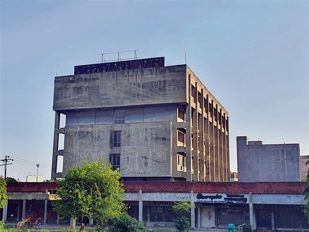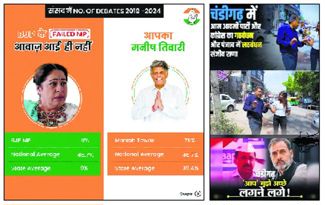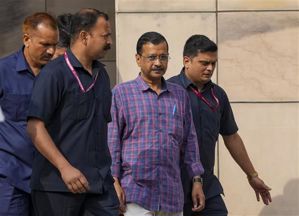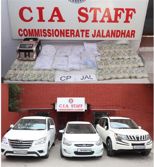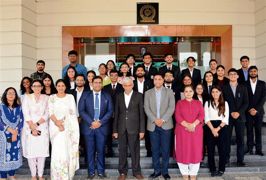
Deepan Sivaraman’s ‘The Legend of Khasak’ was performed in a massive field at Thrikkaripur in Kerala.
Neelam Mansingh Chowdhry
Space is both tangible and atmospheric. The famous quote, ‘You could cut the atmosphere with a knife,’ is self-explanatory. It could be a furniture-laden space, a meditative space, an art gallery, a black box, a proscenium stage, a hall with lots of windows or no windows, or an empty space.
![10501866cd _no photo description available_[4].jpg](https://englishtribuneimages.blob.core.windows.net/gallary-content/2024/1/2024_1$largeimg_265483891.jpg)
photo: radhika agarwal
Spaces are not unfilled or unfulfilled vessels. They contain myriad memories and longings. Each space asserts its presence that you decode, unravel and understand. Happy space, sad space, celebratory space, so on and so forth. Imagine an empty space in your mind’s eye, which may need to be melded, changed, rearranged or sometimes even junked. It depends on the memories that are packaged within the space. Is space the catalyst to determine equations? A challenge for fresh memories to be rewritten? A remembering, a forgetting?
In Lewis Carroll’s ‘Alice in Wonderland’, “Imagination is the only weapon in the war with reality.”
Does this all sound too abstract? Then let me explain with a short story.
I was invited to conduct a masterclass at a drama school and found myself placed on a podium, 3 feet above the ground. The students were seated in semi-darkness, while I was flooded in spotlight. I started my speech with a certain degree of enthusiasm and slowly started feeling disembodied, unconnected, ghostly. I could not see the students clearly, could not decipher their response, reactions! No energy flowed, leading to a complete absence of exchange. My class faded into nothingness, and I felt myself dissipating into an amorphous blob, bewildered by the unexpectedness of it all.
A few days later, a similar opportunity presented itself, and I insisted on seeing the visuals of the space in which the talk was being held. A narrow sunlit space was identified; not perfect, but with the possibility of connections being made. During the process of the talk, I could feel the current of shared ideas and thoughts, and the question-and-answer session flowed. The relationship between me and the receiver was real and palpable.
Space matters, in theatre, and in life. The challenge is to explore the endless ways in which it can be transformed, articulated and animated.
Auditoriums are the pride of any city. Most corporations and governmental agencies envision them as huge spaces for multiple usages. A theatre performance, a pop concert, a seminar, or an AGM meeting, are envisaged during construction, unmindful of the fact that these activities are as different as chalk and cheese. The focus is on sumptuous push-back chairs, silent air-conditioning, lush velvet curtains, accoutrements that are necessary but not mandatory. Most artistes/performers desire something intimate, personalised. Plays have been performed on rooftops, viewed through keyholes, and in abandoned buildings. For an explosion of life to happen, perfect thousand-seaters, with glossy curtains and flies, lights and colour projectors are not the criterion. The most exciting works that I have seen have played out in burnt-down buildings and street corners, in taverns and warehouses.
‘The Money Opera’, which I recently saw, was directed by Amitesh Grover, a theatre director from Delhi. The venue was a dilapidated building in Delhi’s Okhla area and the audience had to move from one room to another, listening silently, almost accidentally, to the murmurations of ‘lost lives’. Narratives piled on narratives, crisscrossing and entangling into each other, collapsing and collating in a rhizomatic gaze. Who was watching whom, became the troubling question. “‘Money Opera’ needed an abandoned building, but the space needed to be altered by texturing the walls. Interventions became a necessary tool as the fictional world of the play had to inhabit the building. To make the design so invisible that no one notices what was added and what already existed,” says Grover.
To share the experience of an immersive and participatory play, I recall Deepan Sivaraman’s ‘The Legend of Khasak’, an adaptation of OV Vijayan’s famous novel ‘The Legends of Khasak’, which was performed in a massive field at Thrikkaripur in Kerala. A large ground surrounded the audience — or should I say embraced the audience. An actor/tailor invited a member of the audience and measured him for a shirt that was to be tailored during the course of the play. The sound of the tailor’s machine along with the Mappila food served to a few members of the audience made the atmosphere smell of fried fish and coconut oil. The experience was not only olfactory but also gave one the feeling of being transported inside the story.
Another play that made me recognise the role of space in performance was a devised production, ‘The Drive’, which provided one of the most powerful examples of ‘audience as witness’. Individual booths were created, almost like a prison barrack, cramped, overcrowded, with the actors tightly packed in a claustrophobic space. The audience bullied, cajoled and also empathised with the actors, while the actors shared their stories undeterred by the jeering audience or the appreciative applause. A panopticon penitentiary making the private/public lines dissolve.
The question that arose while watching the show: who was watching whom? Who was the performer and who was the audience? From this experience, I recognised that we don’t only go to watch a play, but take ourselves to the show.
In most performances held in an auditorium, we sit in neat rows in the dark, hardly acknowledging the presence of strangers with whom we sit shoulder to shoulder, and certainly never expecting the actors to invade our space, or to stake a claim to theirs.
‘The Empty Space’ written by Peter Brook turned every pre-conceived notion on its head. “I can take any empty space and call it a bare stage. A man walks across this empty space whilst someone else is watching him, and this is all that is needed for an act of theatre to be engaged.” This book created a storm and in one instant changed the approach and affirmed that all that was required to make a play was an empty space.
Join Whatsapp Channel of The Tribune for latest updates.





















